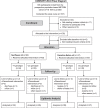The FADS1 rs174550 Genotype Modifies the n-3 and n-6 PUFA and Lipid Mediator Responses to a High Alpha-Linolenic Acid and High Linoleic Acid Diets
- PMID: 36367234
- PMCID: PMC10077898
- DOI: 10.1002/mnfr.202200351
The FADS1 rs174550 Genotype Modifies the n-3 and n-6 PUFA and Lipid Mediator Responses to a High Alpha-Linolenic Acid and High Linoleic Acid Diets
Abstract
Scope: The fatty acid composition of plasma lipids, which is associated with biomarkers and risk of non-communicable diseases, is regulated by dietary polyunsaturated fatty acids (PUFAs) and variants of fatty acid desaturase (FADS). We investigated the interactions between dietary PUFAs and FADS1 rs174550 variant.
Methods and results: Participants (n = 118), homozygous for FADS1 rs174550 variant (TT and CC) followed a high alpha-linolenic acid (ALA, 5 percent of energy (E-%)) or a high linoleic acid (LA, 10 E-%) diet during an 8-week randomized controlled intervention. Fatty acid composition of plasma lipids and PUFA-derived lipid mediators were quantified by gas and liquid chromatography mass spectrometry, respectively. The high-LA diet increased the concentration of plasma LA, but not its lipid mediators. The concentration of plasma arachidonic acid decreased in carriers of CC and remained unchanged in the TT genotype. The high-ALA diet increased the concentration of plasma ALA and its cytochrome P450-derived epoxides and dihydroxys, and cyclooxygenase-derived monohydroxys. Concentrations of plasma eicosapentaenoic acid and its mono- and dihydroxys increased only in TT genotype carriers.
Conclusions: These findings suggest the potential for genotype-based recommendations for PUFA consumption, resulting in modulation of bioactive lipid mediators which can exert beneficial effects in maintaining health.
Keywords: FADS; alpha-linolenic acid; eicosanoid; eicosapentaenoic acid; linoleic acid; octadecanoid.
© 2022 The Authors. Molecular Nutrition & Food Research published by Wiley-VCH GmbH.
Conflict of interest statement
The authors declare no conflict of interest.
Figures





Similar articles
-
Modification in mitochondrial function is associated with the FADS1 variant and its interaction with alpha-linolenic acid-enriched diet-An exploratory study.J Lipid Res. 2024 Oct;65(10):100638. doi: 10.1016/j.jlr.2024.100638. Epub 2024 Aug 31. J Lipid Res. 2024. PMID: 39218219 Free PMC article.
-
Dietary n-3 alpha-linolenic and n-6 linoleic acids modestly lower serum lipoprotein(a) concentration but differentially influence other atherogenic lipoprotein traits: A randomized trial.Atherosclerosis. 2024 Aug;395:117562. doi: 10.1016/j.atherosclerosis.2024.117562. Epub 2024 Apr 23. Atherosclerosis. 2024. PMID: 38714425 Clinical Trial.
-
Inflammatory response to dietary linoleic acid depends on FADS1 genotype.Am J Clin Nutr. 2019 Jan 1;109(1):165-175. doi: 10.1093/ajcn/nqy287. Am J Clin Nutr. 2019. PMID: 30624587 Clinical Trial.
-
The impact of fatty acid desaturase genotype on fatty acid status and cardiovascular health in adults.Proc Nutr Soc. 2017 Feb;76(1):64-75. doi: 10.1017/S0029665116000732. Epub 2016 Aug 16. Proc Nutr Soc. 2017. PMID: 27527582 Review.
-
Influence of fatty acid desaturase (FADS) genotype on maternal and child polyunsaturated fatty acids (PUFA) status and child health outcomes: a systematic review.Nutr Rev. 2020 Aug 1;78(8):627-646. doi: 10.1093/nutrit/nuz086. Nutr Rev. 2020. PMID: 31943072 Free PMC article.
Cited by
-
The Role of Polyunsaturated Fatty Acids in Osteoarthritis: Insights from a Mendelian Randomization Study.Nutrients. 2023 Nov 15;15(22):4787. doi: 10.3390/nu15224787. Nutrients. 2023. PMID: 38004181 Free PMC article.
-
Dihomo-γ-Linolenic Acid (20:3n-6)-Metabolism, Derivatives, and Potential Significance in Chronic Inflammation.Int J Mol Sci. 2023 Jan 20;24(3):2116. doi: 10.3390/ijms24032116. Int J Mol Sci. 2023. PMID: 36768438 Free PMC article. Review.
-
Effect of FADS1 SNPs rs174546, rs174547 and rs174550 on blood fatty acid profiles and plasma free oxylipins.Front Nutr. 2024 Jul 3;11:1356986. doi: 10.3389/fnut.2024.1356986. eCollection 2024. Front Nutr. 2024. PMID: 39021601 Free PMC article.
-
Dietary Fatty Acids and Inflammation: Focus on the n-6 Series.Int J Mol Sci. 2023 Feb 26;24(5):4567. doi: 10.3390/ijms24054567. Int J Mol Sci. 2023. PMID: 36901998 Free PMC article. Review.
References
-
- Glaser C., Heinrich J., Koletzko B., Metabolism 2010, 59, 993. - PubMed
-
- Kathiresan S., Willer C. J., Peloso G. M., Demissie S., Musunuru K., Schadt E. E., Kaplan L., Bennett D., Li Y., Tanaka T., Voight B. F., Bonnycastle L. L., Jackson A. U., Crawford G., Surti A., Guiducci C., Burtt N. P., Parish S., Clarke R., Zelenika D., Kubalanza K. A., Morken M. A., Scott L. J., Stringham H. M., Galan P., Swift A. J., Kuusisto J., Bergman R. N., Sundvall J., Laakso M., et al., Nat. Genet. 2009, 41, 56. - PMC - PubMed
-
- Lankinen M. A., Fauland A., Shimizu B.‐i., Ågren J., Wheelock C. E., Laakso M., Schwab U., Pihlajamäki J., Am. J. Clin. Nutr. 2019, 109, 165. - PubMed

